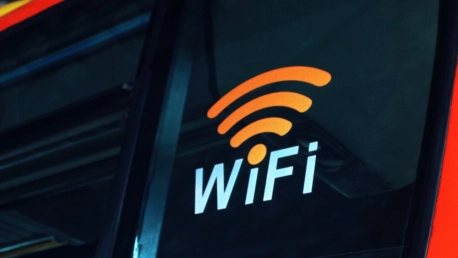Any tech enthusiast knows that once a new technology is launched, another one is already waiting around the corner. Wi-Fi 6 hasn’t been on the market too long, but it already outperforms the Internet service available to most people. Upgrading to a new version of Wi-Fi sounds good, but, for now, specifications are still in draft form and await final approval from the FCC. Even though some manufacturers are already promising to ship Wi-Fi 7 compatible products, the standard may change before approval. Let’s see how fast Wi-Fi 7 will be and why it might make wired Ethernet connections obsolete for some home users and professionals.
Theoretical maximum speeds vs. real-world throughput
Most businesses already have routers capable of supporting Wi-Fi 5, technically known as 802.11ac. It can support a maximum transfer rate of 3.5 gigabits per second (Gbps).
However, this is the theoretical maximum speed achievable under optimal conditions, and the actual speed is influenced by factors such as internet plan, Wi-Fi router location and surroundings, and interference from nearby networks. For example, if construction was made using a certain brick type, signal reception could be problematic in the opposite corners of the router’s location. Luckily, for these situations, there are some simple solutions for expanding your office Wi-Fi network.
Under optimal conditions, Wi-Fi 7 is expected to boost maximum bandwidth up to 40 gigabits per second, which is four times faster than Wi-Fi 6. Such high bandwidth is obviously excessive for Web browsing, but it is required for augmented reality (AR) and virtual reality (VR) applications. Many businesses are already using Wi-Fi 6 routers. If they were to upgrade right now to the preliminary specs of Wi-Fi 7, the improvement in speed capabilities would not be as dramatic as the upgrade from Wi-Fi 5, but it would still be impressive. Under optimal conditions, Wi-Fi 6 and 6E can reach speeds of up to 9.6 Gbps, just a third of 7’s capacity.
Wi-Fi 6E already has access to the 6 GHz band, thus avoiding congestion issues in the 2.5 GHz and 5 GHz bands. What the 6E lacks, however, is something called Multi-Link Operation (MLO), which further enhances Wi-Fi 7’s ability to avoid interference. This means that Wi-Fi 7 will handle the same channels as 6E, but more efficiently. Other advantages over 6 and 6E include higher quadrature amplitude modulation (QAM) and channel bandwidth. While Wi-Fi 6 can handle up to eight independent data streams, Wi-Fi 7 raises that to 16 spatial streams.
The end of wired connections?
At the moment, a wired internet connection is almost always faster and more reliable than Wi-Fi. In theory, a Wi-Fi 7 connection could be faster than a wired one, but only if we’re talking about Ethernet cables rated below Cat-8, which is a category of Ethernet cable capable of speeds of up to 40 Gbps. That said, Cat-8 is mainly intended for data centers, not for home users. The cables sold with typical commercial routers are either Cat-5 or Cat-6, rated at 10 Gbps at most.
As always, these comparisons are only valid if the network in question is configured optimally, which is sometimes very difficult to do. While Wi-Fi 7 will bring improvements in the fight against interference and latency, it is unclear how well it will perform.
So, will we soon be surfing the internet at 40 Gbps over wireless? If we’re being realistic, the answer is no! Aside from the previously mentioned factors, most internet plans are unlikely to even come close to that speed. The network infrastructure would need to be upgraded as well.
Vendors launch Wi-Fi 7 products
Wi-Fi 7 is based on the draft 802.11be standard, published in May 2021. Although the standard has not yet been finalized or approved by the FCC, multiple vendors have already launched Wi-Fi 7 capable products.
In January 2022, MediaTek held the world’s first live demo of Wi-Fi 7 for “key customers and industry collaborators,” paving the way for the wireless network technology to enter mainstream consumer hardware as early as next year, according to the company. The demos, according to the Taiwan-based company, revealed the ability of Wi-Fi 7 to achieve the maximum speed defined by IEEE 802.11be, the official name for the Wi-Fi 7 standard. The company also emphasized its multi-link operation (MLO) technology.
In April 2022, Broadcom introduced a comprehensive Wi-Fi 7 portfolio, detailing multiple 802.11be radios for access points, a networking SoC designed with 802.11be bandwidth in mind, and a client radio for mobile applications.
Qualcomm’s unveiled Wi-Fi 7 platforms for access points and home routers on May 4th. Qualcomm announced the arrival of the Wi-Fi 7 Networking Pro Series—a lineup of Wi-Fi chips designed for enterprise access points, premium home routers, and advanced mesh systems.
Conclusion
The new Wi-Fi 7 standard promises improvements in all aspects of Wi-Fi, including throughput, connection quality, and range, but there is no need to declare the end of cable connections just yet. Wi-Fi 7 will materialize gradually, and consumer-grade devices will not be available for purchase for at least another year, if not longer. In the meantime, business managers and tech enthusiasts can purchase routers that support Wi-Fi 6 (and Wi-Fi 6E), which is still impressive when compared to previous Wi-Fi standards.









